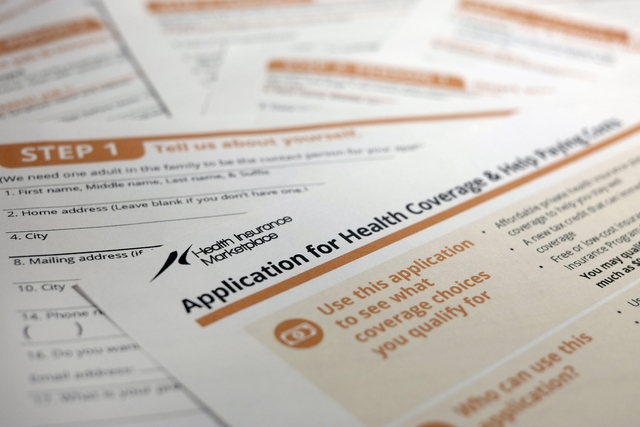OBAMACARE EXPLAINED: Peering into prescription drug ‘doughnut hole’
Open enrollment ends Monday, but that hasn’t stanched the flow of questions about the Affordable Care Act.
This week, readers want to know more about Medicare coverage gaps and the billing practice that seems to have caused problems getting some consumers the coverage they’ve chosen.
We also share a bit more about just how close Xerox came to losing in its bid to build Nevada Health Link.
■ A reader who didn’t give his name wants to know what’s going on with the Medicare prescription-drug “doughnut hole,” which the Affordable Care Act is supposed to close.
That doughnut hole will indeed disappear, but you’ll have to be patient: Filling it will take nearly a decade.
The doughnut hole was in full effect until 2010. Here’s how it worked: Recipients of Medicare, the federal insurance program for people older than 65, were responsible for 100 percent of prescription costs until they hit a $310 annual deductible. At $311, they began paying 25 percent. Once drug costs hit $2,850, though, patients had to go back to paying 100 percent. Then, if annual drug spending surpassed what Medicare considered a catastrophic level of $4,550, recipients were on the hook for just 5 percent of the bill.
That no-coverage gap from $2,850 to $4,550 is the dreaded doughnut hole.
When the Affordable Care Act passed in 2010, it began eating away at the doughnut hole. No one has to cough up 100 percent of costs in the gap anymore. Through 2014, recipients will pay 47.5 percent of the cost of brand-name drugs and 72 percent of the cost of generics. That slowly drops to 25 percent in 2020, when the doughnut hole officially closes. The rate of out-of-pocket costs will stay at today’s 5 percent if prescription spending exceeds $4,550.
■ From the “they-told-you-so” files: We wrote recently about “premium aggregation,” an unusual practice that could be affecting paid enrollments through the Nevada Health Link exchange. We decided to examine the concept a bit more after a reader named Carson tweeted that there was some controversy when the exchange board discussed it two years ago.
We thought we’d check it out, because premium aggregation — in which exchange contractor Xerox bills consumers for coverage and forwards payments to carriers — is likely behind at least some billing issues the state exchange is having.
Nevada is the only state that runs exchange-based premium payments through a contractor rather than through insurers. But looking back over exchange board meetings in late summer of 2012, it seems the only people who warned against the practice were insurance carriers themselves.
Leanne Gassaway of trade group America’s Health Insurance Plans told board members in September 2012 that adding a third party to billing “not only delays (a transaction), but offers an opportunity for errors and omissions to occur.”
Carriers also told the exchange board that using Xerox to process payments would make it harder for them to simply roll over plans from year to year, and it would duplicate services and add to system costs.
An analysis from the exchange found that letting Xerox aggregate premiums would add $5.2 million to the contract cost, driving it from $66.8 million to $72 million, though the entire contract’s cost would be covered by federal startup grants.
Premium aggregation would have benefits, advocates on the exchange staff said. It would consolidate payments for households with private medical insurance, kids on the state’s Children’s Health Insurance Program, and vision and dental coverage. Xerox said carriers could save $3.725 in administrative costs on each policy, or $9 on a $300 monthly premium. The company also testified that premium aggregation would improve customer service and member retention. One board member even suggested the practice could be a marketing tool.
The exchange board decided the positives outweighed the negatives, and voted to let Xerox handle billing.
Now, an unknown number of consumers are in billing limbo. The exchange said March 14 that it had 241 consumers who have paid for a plan but have no coverage. More than 10,500 others were on the “pends” list, which exchange officials said consists of people who have chosen a plan but not made a payment. There’s confusion on that, too, because brokers and consumers alike tell the Las Vegas Review-Journal of people on the pends list who have sent in premiums but are still listed as unpaid.
Gov. Brian Sandoval told the Review-Journal on March 13 that channeling premium payments was perhaps “the big chunk that Xerox bit off that they couldn’t handle.”
As the first open-enrollment session crawls to its Monday close, there are signs that billing practices may be different when the next enrollment period launches Nov. 15: The exchange board was scheduled to discuss premium aggregation in its Thursday meeting.
■ So close, yet so far away: Sandoval also revealed the hair’s-breadth difference between contractors who submitted bids in 2012 to build Nevada Health Link.
Bids came from four companies: Xerox, Deloitte Consulting, Choice Administrators and KPMG. A panel of state management employees scored companies on financial stability; demonstrated competence; experience and performance on comparable contracts; expertise and availability of key personnel; and cost.
Xerox edged out Deloitte by a barely noticeable four points, Sandoval said, but state law requires the project go to the bidder with the highest score, with no discretion.
But Deloitte is now working on the project anyway, with its $1.5 million contract to evaluate what’s wrong with Nevada Health Link and how it can be fixed before November.
Deloitte has worked on exchanges in four other states — Connecticut, Kentucky, Rhode Island and Washington. For the most part, those states have had success signing up enrollees. A December report from USA Today found that the four states’ websites have “run especially smoothly,” though Connecticut’s online exchange had some early browser-compatibility issues.
Deloitte’s report on Nevada Health Link is due sometime in late April or early May.
Contact reporter Jennifer Robison at jrobison@reviewjournal.com or 702-380-4512. Follow @J_Robison1 on Twitter.




























